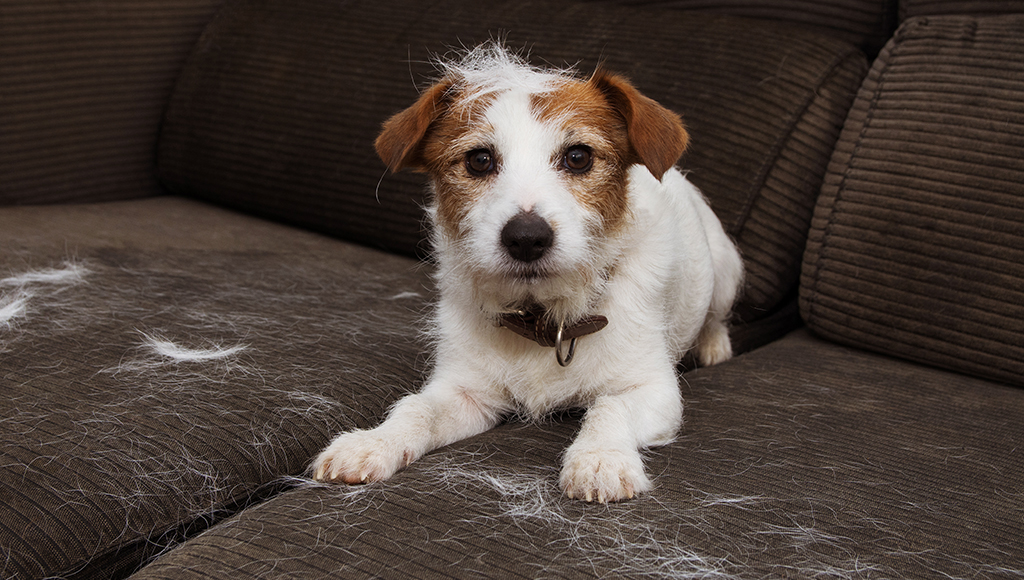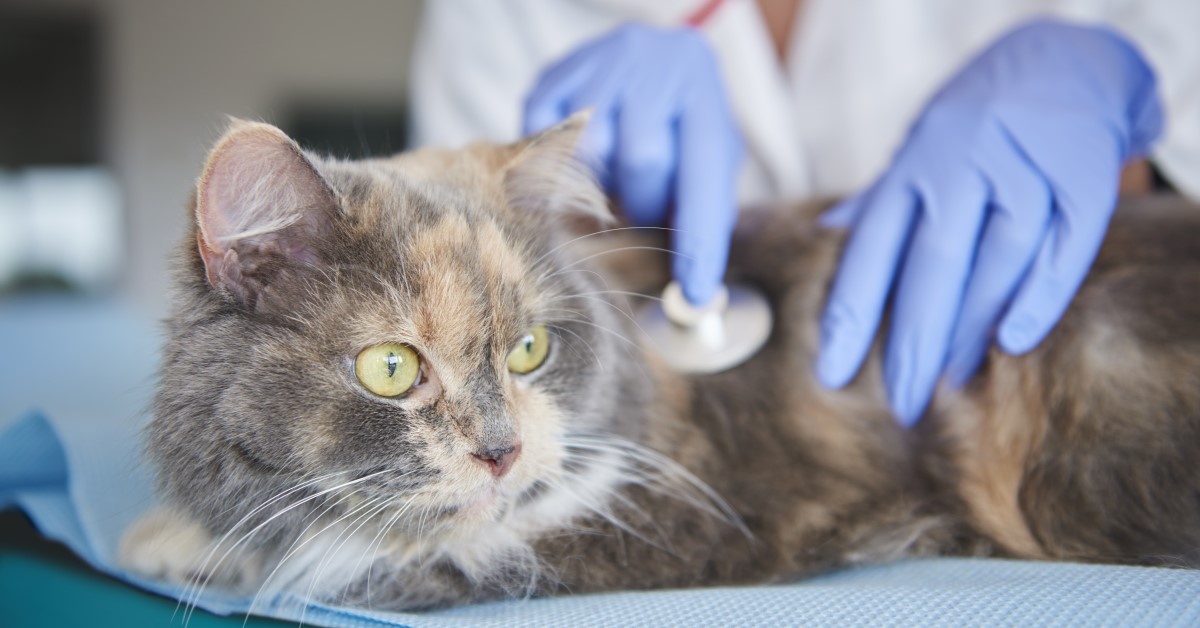Different Types of Pet Hair Loss
There are a variety of factors that can cause hair loss in your pet.

What is Hair Loss?
Hair loss on a dog or cat is the abnormal thinning or complete loss of hair in one area or the entire body of the animal. The medical term for hair loss is alopecia. Hair loss is so common that it is one of the main reasons pets visit their veterinarians. Hair loss always indicates a medical problem, and fortunately the most common cause is an allergic reaction to fleas. Hair loss caused by fleas is easily remedied with topical flea treatments and thorough removal of fleas from the animal's environment. The opposite of hair loss is excessive hair growth, know as hirsutism, which is also considered a medical problem.
How does hair grow?
Hair begins growth within a little pocket called a follicle where it is nourished by proteins and other materials in the blood. Blood also carries hormones, such as epidermal growth factor, that determine the growing, resting, regressing, and shedding phases of the hair. Hormones that control hair growth are influenced by sunlight and temperature, which is why many pets have major growing and shedding cycles each spring and fall. With more and more pets kept indoors in a controlled climate, marked growing and shedding cycles are becoming less frequent, and many pets appear to now shed more evenly throughout the year.
There are some dogs that do not shed very much at all. These dogs have hair that grows constantly and can become very long. Poodles and Shih Tzus are good examples of dogs with constantly growing hair. Although these pets don’t shed, their coats require care, usually clipping every 4-6 weeks in order to keep it at a manageable and optimal length.
Comparing hair growth to leaf growth
Hair grows in cycles or phases, which is easy to understand when hair is compared to leaves on trees. Trees have new leaf growth in the spring, then during the summer leaves stay active but are no longer increasing in number. In the fall, leaves die. In late fall, they fall from the tree. For hair, the growing phases are very similar:
- growth phase (anagen)
- resting phase (telogen)
- regressing phase (catagen)
- shedding phase (exogen)
Hairs over the body don’t move through the phases at the same rate. For example, hair over the back and hips grows more slowly than hair on the chest. The rate at which hair grows is influenced by hormones and by blood supply. A good blood supply brings nutrients and a normal concentration of hormones so that the area experiences healthy hair growth. Areas with a poor blood supply do not have healthy hair growth.
Number of hairs per follicle
Unlike humans who have one of a few hairs growing in each follicle, most dogs and cats have many hairs in each follicle. With so much hair in a follicle, when follicles go through the shedding phase there is lots of hair to clean up.
What other structures are found in the skin with the hair?
In addition to hair and hair follicles, skin has muscles to erect the hair and nerve endings that sense temperature, pressure, and pain. Oil glands (sebaceous glands) are found deep in the hair follicle or next to the hair follicle. These oil glands secrete a thin oil called sebum that holds moisture in the skin and in the hairs. Brushing stimulates sebum secretion and spreads it over the coat. Sweat glands are also found in the skin, and they are concentrated in the non-haired areas, such as the foot pads, around the corners of the mouth, and under the chin.
What causes hair to fall out?
Hair loss can be caused by a variety of conditions:
- Skin parasites
- Infections
- Allergies
- Nutrition
- Organ function
- Blood flow
- Hormones
- Topical medications
- Behavior
Skin parasites and infections
Parasitic fleas, lice, and mites cause hair loss because they cause itching. The pet scratches or bites vigorously and the hair is chewed or broken off. The moist, chewed skin is ripe for skin infections with yeast, ringworm, or bacteria. The yeast, ringworm, and bacteria also cause itching, and even more hair is chewed off. Where the dog and cat hair loss occurs suggests which parasite is involved. Fleas attack the back over hips; lice often attack the back and back legs; mites focus on eyes, ears, mouth, and elbows.
Allergies
When humans are allergic, our eyes water, our noses run, and we itch. With pets, allergies are expressed in the skin and ears rather than the eyes and nose. Allergic pets have itchy skin, and in response they scratch or chew out their hair. Pets can be allergic to the following:
- Foods - are caused by grains (wheat, corn, soy), meats and
fish (beef, lamb, pork, salmon), milk and yeast.
- Inhaled allergen and materials their skin contacts - are pollens, cigarette smoke, and perfumes especially those added to cat litter. Pets can experience contact allergies when they walk through grass, across chemically treated decks, on carpets with chemical in the carpet or underpad.
The Importance of Nutrition
Hair requires a constant supply of nutrients to remain anchored in the skin. Nutrients that support healthy hair are the same as those that support healthy skin: vitamins, minerals, antioxidants, and Omega 3 and Omega 6 fatty acids. Hair that doesn’t receive a balanced supply of nutrients becomes dull, loosens, and falls out. For example, pets on starvation diets have thin, dull coats. Hair loss due to poor nutrition often involves the whole pet, but may be most obvious over areas that are easily worn and over the back and hips where hair follicles have shorter growth cycles and longer inactive periods.
Some northern dog breeds, such as the Siberian Husky, have a
genetic tendency to zinc deficiency that leads to skin and coat
problems. The problem is in the pet’s inability to absorb zinc,
which is usually present in adequate amounts in the diet. The
medical term for this condition is
Alopecia X.
How Organ Function Affects Hair Loss
Because the kidneys, liver, intestines, and other organs regulate the nutrients in the blood, diseases and drugs affecting these organs directly influence hair loss. For example, pets with inflammatory bowel disease, cancer or on chemotherapy often have dull, thinning hair throughout. Pets with kidney failure often have bedraggled, dull coats and may have a strong smell of urine from their skin. Pets with liver failure have orange-yellow skin (jaundice), and nails that grow long but are weak and flaky.
Blood flow
Hair is a living element anchored in the follicle and nourished by blood for most of its cycle. When the blood doesn’t circulate, hair will not grow well. Pets with weak hearts, low blood pressure, and chronic anemia may have cool skin and unthrifty coats. The thinning coat is from hair being lost from the follicle rather than being licked and broken off.
Hormones
Hormones are chemical messengers made in one part of the body and used in other parts. Some hormones travel throughout the body, and other hormones travel only as far as the cells around them. Many hormones influence hair growth, including testosterone, estrogen, melatonin, growth hormone, thyroxin, and cortisol. Abnormal levels of these hormones cause hair to be too thin or to be too thick. Examples of how thyroxin and cortisol affect the hair follow.
The thyroid gland in the neck makes the hormone thyroxin which travels through the blood and influences almost every cell in the body. Thyroxin increases the rate that cells grow and multiply because it stimulates the cell’s nuclear machinery. Hair follicles and skin cells are strongly influenced by thyroxin. With normal thyroxin levels, hair growth is normal. With insufficient thyroxin, which usually occurs in dogs (hypothyroidism), hair growth is thin, especially over the back. With excess thyroxin, which usually occurs in cats (hyperthyroidism), the coat is poorly groomed and matted over oily clumps of skin cells.
Cortisol is a hormone released from the adrenals that is carried by the blood and influences most cells in the body. When cortisol levels are too high—due to Cushing’s disease or cortisol medication overload—hair thins even pattern over the back all down the tail, leaving a tuft of hairs at the very end (rat tail). If hair is clipped anywhere on the body, it grows back very slowly. When cortisol levels are too low—hypocortisolemia or Addison’s disease—hair loss may also occur.
Oral, Topical, and Injected Medications
Several oral, topical and injected medications can cause hair loss. For example, high doses or long-term use of oral, topical, or injected steroids can cause hair follicles to shrink and hair to fall out. Hair regrowth is delayed until follicles are no longer influenced by high steroid levels. Some topically applied flea medications cause hair loss at the area of application. Injected vaccines cause hair loss at the injection site and in some pets there is further widespread hair loss over the next few months. Fortunately, this is rare. With all these medications, hair is lost from the follicle rather than bitten off.
Behavior
Pets can develop hair loss because they have behavioral problems. For example, dogs with a separation anxiety behavior disorder lick patches of hair off their legs. This is called acral lick dermatitis. With acral lick dermatitis, dogs can lick so relentlessly that their skin breaks down and becomes infected. What began as anxiety turns into a bacterial and yeast infection that is difficult to cure because the pet licks it whenever they are left alone. The areas normally involved are the front legs just above the wrist (carpus) and back legs near the ankle (tarsus).
Cats can also over-groom or barber themselves until bald spots spread over abdomen and thighs. When over grooming is causing bald spots, the hairs will be broken or chewed off and the only involved areas will be where the pet can reach so the back, head and neck are never involved.
Who develops hair loss?
All pets are susceptible to hair loss, but the following breeds often have their own particular problems. For example, Dachshunds have a breed predilection for thinning over the ears, abdomen, and neck. Hair loss due to hypothyroid disease affects the Afghan hound, Airedale, Boxer, Chow Chow, Cocker Spaniel, Dachshund, Doberman Pinscher, English Bulldog, Golden Retriever, Great Dane, Irish Setter, Irish wolfhound, Miniature and Giant Schnauzer, Newfoundland, Poodle, Scottish Deerhound, and Shetland Sheepdogs.
Hair loss due to hyperadrenocorticism (Cushing’s disease) affects these dog breeds: Beagle, Boston Terrier, Boxer, Dachshund, and Poodle. These breeds grow hair very slowly after being clipped: Siberian Huskies, Alaskan Malamutes, Chow Chows and mixed breed dogs with Northern genetics. These breeds evolved in cold, snowy climates and shed and regrow their hair once a year or once every two years.
Hair loss due to hyperthyroid disease affects many breeds of cats, yet is uncommon in Siamese and Himalayan cats.
Ready to start saving money on pet wellness care?
Then take a look at Mint Wellness, the pet wellness plan that provides fast reimbursement on routine pet care. Save on vaccinations, wellness exams, preventatives, dental, and more!
Learn More


